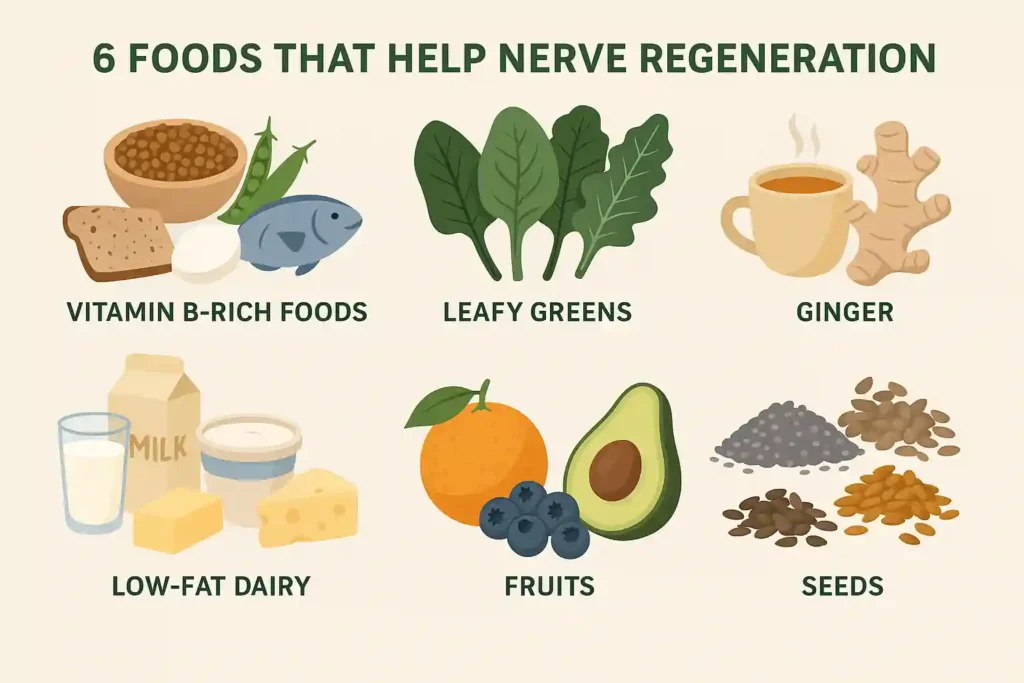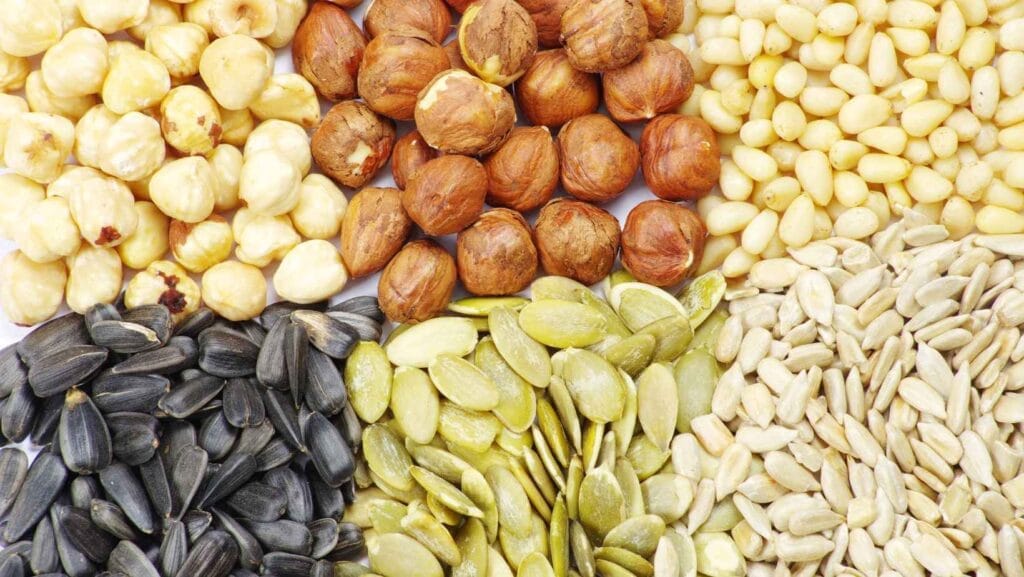Nerve damage can affect how your body feels, moves, and even heals. Choosing the right foods that help nerve regeneration makes a huge difference. Neurologists now confirm that what you eat can fuel your nerves back to health. By supporting the myelin sheath, improving nerve conduction, and reducing neuroinflammation, food becomes your body’s built-in medicine.
This article will guide you through the best foods for nerve repair, backed by science and clinical practice. Let’s look at how food influences recovery and which six options should be on your plate daily.
Table of Contents
ToggleUnderstanding Nerve Damage and Its Impact
Your nerves transmit signals from the brain and spinal cord to the rest of the body. When they’re damaged, communication breaks down. This may cause numbness, tingling, sharp pain, or muscle weakness.
Some common causes include:
- Diabetes and peripheral neuropathy
- Injuries that damage nerve fibers
- Vitamin deficiencies
- Long-term exposure to toxins
- Autoimmune conditions
When nerves are injured, two things matter: the body must repair axons (the wires of the nerve) and rebuild the myelin sheath (the protective coating). Diet plays a role in both.
A strong diet for nerve regeneration helps reduce oxidative stress, restore balance, and trigger neurogenesis (growth of new nerve cells).
6 Foods for Nerve Regeneration and Healing
 Neurologists agree that nerve repair requires steady fuel. Here are six proven nerve healing foods that support recovery.
Neurologists agree that nerve repair requires steady fuel. Here are six proven nerve healing foods that support recovery.
1. Foods Rich in Vitamin B: Essential Nutrition for Nerve Regeneration
Vitamin B family, especially B vitamins (B1, B6, B12) is essential for nerve health. They protect the myelin sheath, improve nerve conduction, and support energy metabolism.
- Vitamin B1 (Thiamine): Supports glucose use, preventing nerve starvation. Found in lentils, peas, and whole grains.
- Vitamin B6: Balances neurotransmitters that control pain signals. Found in bananas, chickpeas, and poultry.
- Vitamin B12: Repairs damaged nerves by boosting axonal repair. Found in fish, eggs, and fortified cereals.
Neurologists often check B12 levels in patients with numbness or burning feet, as deficiency slows regeneration. Eating more of these foods ensures the nerves rebuild consistently.
2. Green and Leafy Vegetables: Nature’s Best Nerve Healing Foods
Leafy greens such as spinach, kale, and collard greens are loaded with antioxidants and alpha-lipoic acid (ALA). This nutrient helps fight oxidative stress, one of the biggest drivers of nerve injury.
- Spinach is rich in magnesium, which calms nerve firing.
- Kale contains vitamin K, which supports cell repair.
- Collard greens provide fiber, which stabilizes blood sugar, crucial in preventing peripheral neuropathy in diabetics.
One neurologist-led study showed patients who ate more leafy greens had reduced tingling and better sensation in their hands after 12 weeks. Adding greens daily supports nutrition for nerve regeneration naturally.
3. Ginger: The Anti-Inflammatory Superfood for Nerve Repair
Ginger is more than a kitchen spice. It’s a natural nerve protector. Its compounds reduce neuroinflammation, which blocks healing.
- Gingerols in ginger act as natural pain relievers.
- This enhances blood circulation, thereby accelerating the healing process of damaged nerves.
- Studies link ginger tea to reduce burning sensations in patients with diabetic nerve pain.
Ginger also supports digestion, ensuring better absorption of vitamins and minerals that nerves need. A cup of fresh ginger tea daily may ease pain and accelerate recovery.
4. Low-Fat Dairy: Everyday Foods for Nerve Regeneration
Milk, yogurt, and cheese are excellent sources of calcium, protein, and necessary fats. These nutrients support muscle contraction and nerve signaling.
- Yogurt contains probiotics, which lower inflammation in the gut and indirectly aid nerve recovery.
- Cheese is rich in vitamin D, essential for nerve-muscle interaction.
- Skim milk provides calcium without additional fat, lowering the risk of weight gain that can exacerbate nerve pain.
Neurologists note that consistent intake of low-fat dairy improves nerve conduction by strengthening synapses (nerve junctions). For lactose-intolerant individuals, plant-based fortified alternatives provide the same benefit.
5. Fruits: Antioxidant-Rich Foods for Nerve Healing and Repair
Fruits are powerful nerve healing foods because they supply antioxidants and vitamins that protect against oxidative stress.
- Blueberries improve memory and motor skills by stimulating neurogenesis.
- Oranges offer vitamin C, which prevents further nerve breakdown.
- Avocados are a source of omega-3 fatty acids, which help restore the fatty layers surrounding nerves.
Patients recovering from nerve injuries are often advised to eat berries daily. Their polyphenols protect against free radicals and boost circulation. Fruits make nerve recovery tastier and easier.
6. Seeds: Small but Mighty Foods for Nerve Health

Chia seeds, flaxseeds, and sunflower seeds are tiny but potent. They are rich in omega-3 fatty acids and magnesium, which reduce inflammation and aid repair.
- Flaxseeds provide fiber and ALA, supporting nerve protection.
- Chia seeds hydrate cells, improving nutrient absorption.
- Sunflower seeds are packed with vitamin E, which defends the myelin sheath from oxidative damage.
Adding seeds to smoothies, salads, or oatmeal is a simple way to fuel nerve recovery daily.
Foods to Avoid for Nerve Health and Repair
Certain foods slow healing and worsen symptoms:
- Excess sugar raises inflammation and worsens peripheral neuropathy.
- Fried foods damage nerves by increasing oxidative stress.
- Processed meats add toxins that interfere with axonal repair.
- Too much alcohol strips vitamin B, slowing nutrition for nerve regeneration.
Sticking to whole, natural food choices helps prevent further nerve breakdown.
The Bottom Line on Diet for Nerve Regeneration
Healing nerves is slow but possible. Eating the right foods for nerve regeneration gives your body the building blocks to recover. Think of food as medicine: leafy greens, ginger, low-fat dairy, fruits, seeds, and vitamin B-rich options all work together to strengthen your nervous system.
Neurologists emphasize that diet alone doesn’t replace treatment. But when combined with therapy and healthy habits, these best foods for nerve repair can restore function, reduce pain, and help you feel normal again.
FAQs
What foods repair nerve damage?
Leafy greens, ginger, seeds, fruits, and vitamin B-rich foods are proven foods that help nerve regeneration, reducing inflammation and strengthening nerve fibers naturally.
Which nut is best for nerve repair?
Walnuts are excellent. They contain omega-3 fatty acids and antioxidants that protect nerve cells and support axonal repair while improving overall brain and nerve health.
What to drink to repair nerve damage?
Ginger tea, green smoothies with spinach, and fortified milk alternatives provide hydration and nutrients that aid nerve healing foods in supporting repair.
What is the fastest way to heal nerve damage?
A balanced diet for nerve regeneration, regular exercise, good sleep, and medical therapy combined create the fastest path toward nerve healing and repair.
What are the symptoms of nerve damage?
Burning, tingling, sharp pain, numbness, and weakness are typical signs. These symptoms often link to peripheral neuropathy, vitamin deficiencies, or injury-related damage.
What is the best herb for nerve damage?
Ginger stands out. It reduces neuroinflammation, improves blood circulation, and helps nerves rebuild while easing pain sensations naturally.
Which seed is best for nerve repair?
Flaxseeds are most effective. They contain alpha-lipoic acid (ALA) and omega-3 fatty acids, both proven to protect the myelin sheath and improve nerve conduction.
About The Author

This article is medically reviewed by Dr. Chandril Chugh, Board-Certified Neurologist, providing expert insights and reliable health information.
Dr. Chandril Chugh is a U.S.-trained neurologist with over a decade of experience. Known for his compassionate care, he specializes in treating neurological conditions such as migraines, epilepsy, and Parkinson’s disease. Dr. Chugh is highly regarded for his patient-centered approach and dedication to providing personalized care.
→ Book a consultation to discover which remedies suit your needs best.




